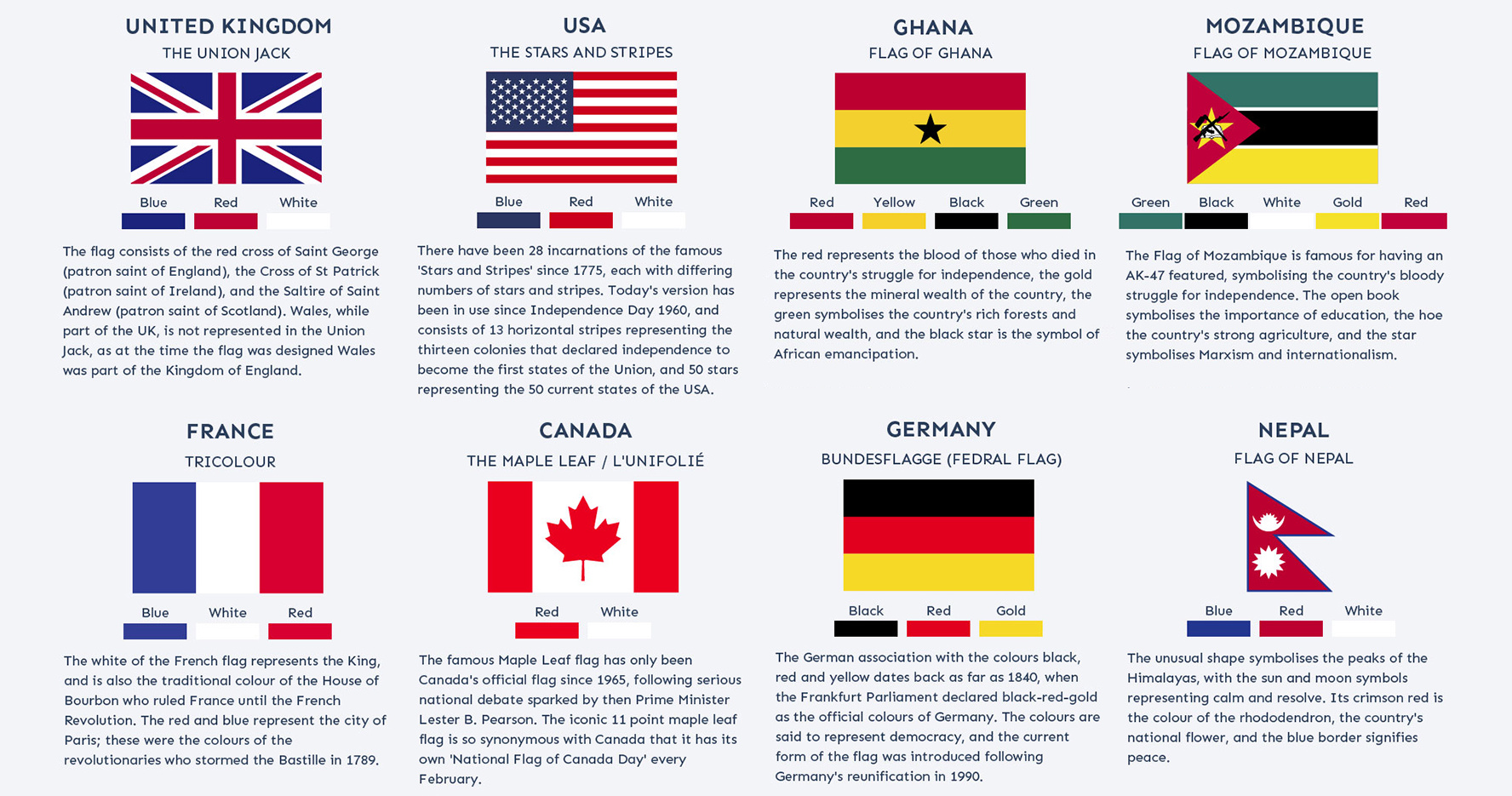Have you ever stopped to consider the meaning behind the colors you see flying proudly on flags around the world? Each hue, from vibrant red to calming blue, holds a unique story, often reflecting the history, values, and aspirations of a nation.

Image: mavink.com
Flags, as powerful symbols of identity and belonging, are more than just pieces of fabric. They are visual representations of a country’s spirit, its triumphs, and its hopes for the future. Understanding the symbolism embedded within these vibrant colors allows us to appreciate the rich tapestry of human culture and the diverse stories they tell.
Unveiling the Language of Colors
Colors, across cultures, are often imbued with symbolic meaning, and flags are no exception. Think of the bright red of the Chinese flag, representing revolution and passion, or the peaceful blue of the United Nations flag, symbolizing harmony and unity. These colors are more than just visual elements; they are powerful communicators that speak volumes about the values and ideals a nation cherishes.
Common Color Symbolism in Flags
While the specific meaning of each color can vary slightly depending on the context and cultural interpretation, there are some commonly associated meanings found in flags around the world:
- Red: often represents courage, strength, passion, and sacrifice. It can also symbolize revolution, blood, and war.
- Blue: commonly associated with peace, freedom, loyalty, and justice. It can also symbolize the sea, sky, and stability.
- Green: frequently linked to nature, hope, fertility, and prosperity. It can also represent agriculture, Islam, and the environment.
- Yellow: often signifies optimism, joy, prosperity, and intelligence. It can also stand for gold, wealth, and the sun.
- White: typically associated with purity, peace, innocence, and honesty. It can also represent surrender, neutrality, or death.
- Black: often symbolizes strength, power, mourning, or death. It can also represent mystery or rebellion.
Case Studies: Decoding Colors in Iconic Flags
To better understand this intricate language of colors, let’s delve into some iconic flags and unravel the meaning behind their hues.

Image: mavink.com
The United States Flag: A Tapestry of Freedom and Unity
The American flag, with its bold red, white, and blue, is a classic example of color symbolism. The red stripes represent courage, sacrifice, and the blood spilled in the pursuit of freedom. The white stripes symbolize purity, honesty, and new beginnings, representing the ideals of the American experiment. The blue field, representing vigilance, perseverance, and justice, also houses 50 white stars, one for each state, signifying unity and a shared destiny.
The French Flag: A Declaration of Liberty, Equality, and Fraternity
The French flag, known as the Tricolore, displays three vertical bands of blue, white, and red. The blue represents liberty, freedom, and the ideals of the French Revolution. White symbolizes equality and purity, signaling a break from the old order. Red, reminiscent of the blood spilled during the revolution, signifies brotherhood, resilience, and the sacrifices made for freedom.
The Indian Flag: A Reflection of Diversity and Aspirations
The Indian flag, with its saffron, white, and green, reflects the country’s rich culture and its aspirations. Saffron represents courage, sacrifice, and renunciation, while white symbolizes peace and truth. The green band, representing fertility, prosperity, and the land, also bears a blue wheel (Ashoka Chakra) symbolizing dharma (righteous conduct), progress, and peace.
Beyond the Colors: Exploring Further Layers of Meaning
While colors play a vital role in interpreting a flag’s symbolism, it’s essential to consider other factors. The design itself – the arrangement of stripes, stars, or other figures – can add another layer of meaning. For instance, the three stars on the Australian flag represent the six states, grouped in pairs to symbolize unity.
Additionally, the history behind a flag’s creation and its evolution over time can significantly influence its symbolism. The South African flag, with its rainbow of colors, signifies the country’s commitment to diversity and reconciliation after the apartheid era.
Contemporary Trends in Flag Design
Flags, like all cultural expressions, are constantly evolving. Current trends in flag design include:
- Minimalism: Many new flags are adopting simple designs and a reduced number of colors, focusing on clarity and impact.
- Geometric Shapes: Geometric shapes, such as triangles and squares, are increasingly incorporated into flag designs, adding a modern aesthetic and a sense of structure.
- Cultural Inclusiveness: Flags are becoming more reflective of diverse populations, incorporating elements that represent different cultural groups within a nation.
What Do The Colors On A Flag Mean
Conclusion: A Visual Language That Connects Us
Learning about the meaning of colors in flags is a fascinating journey into the heart of nations. It allows us to appreciate the rich history and cultural identity woven into these vibrant symbols. Understanding the language of colors helps us connect with our shared heritage and celebrate the diversity of human expression. So, the next time you see a flag waving proudly, take a moment to appreciate the story it tells, the values it represents, and the unity it embodies.





